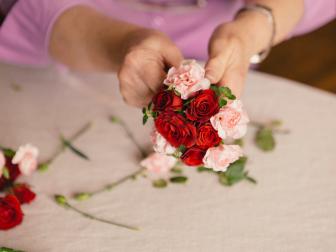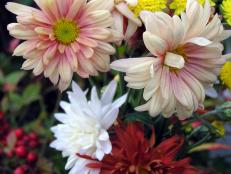How to Grow Dianthus Flowers
Cottage garden favorites including Sweet William, cheddar pinks and carnations will add an attractive pop of color to any yard.

Dianthus plants are cottage garden favorites with plenty of variety. They belong to a genus of flowering plants in the family Caryophyllaceae. Dianthus plants are herbaceous perennials that commonly have pink, red or white flowers with notched petals. They are easy-to-grow flowers that multiply readily, are sweetly fragrant, deer-resistant and make excellent cut flowers.

Shutterstock/MintImages
Types of Dianthus
The most common varieties seen in gardens are Sweet William, cheddar pinks and carnations.

Ball Horticultural Company
Sweet William (Dianthus barbatus):
- Zone: 3 to 9
- Height: 1' to 2'
- Spread: 1/2' to 1'
- Bloom Time: May to frost
- Bloom Description: Red, pink, white and bicolor
- Sun: Full sun to part shade
- Water: Medium
- Uses: Since this is a short-lived perennial, it's best grown as a biennial or annual (in cold climates.) Sweet William works well in cottage gardens, beds and borders and containers.

Ball Horticultural Company
Cheddar Pinks (Dianthus gratianopolitanus)
- Zone: 4 to 8
- Height: 1/2 ' to 1'
- Spread: 1' to 2'
- Bloom Time: May to July
- Bloom Description: Rose pink
- Sun: Full sun
- Water: Medium
- Uses: Cheddar pinks are perennials that work best in beds and borders, as edgings, planted in mass near doors or walkways and in containers. They are perfect for difficult growing sites such as rocky slopes.

Ball Horticultural Company
Carnation (Dianthus caryophyllus)
- Zone: 5 to 9
- Height: 1' to 1-1/2'
- Spread: 3/4' to 1'
- Bloom Time: June to July
- Bloom Description: various and bicolor
- Sun: Full sun
- Water: Medium
- Uses: There are dozens of carnation varieties. Typically, they have slender, blue-green foliage and sweetly scented blooms that come in a variety of colors including bright pinkish-purple, red, white, yellow, blue and green. They make excellent cut flowers and are often used in borders.
How to Use Dianthus
Dianthus plants make an attractive addition to any garden. Incorporate Dianthus plants such as Sweet William or carnations in the front of garden borders. Low-growing cheddar pinks can be used as a ground cover for a pop of color and added dimension in a landscape. Dianthus plants attract pollinators and are deer resistant.
How to Grow Dianthus
All dianthus prefer full sun (at least six hours per day.) They like rich soil that has two to four inches of well-rotted compost. Work the compost to a depth of 12 inches before planting and reapply a top dressing of compost in spring.
You can start dianthus from seed about eight weeks before the last frost in spring and transplanted outside after frost. Dianthus seeds can also be sown directly in the garden in summer. Transplants can be added to the garden in the spring or fall. Space plants 6" to 12" apart (depending on the type.)
Add mulch to the base of the plants to help retain soil moisture and maintain even soil temperatures. Water the plants thoroughly at least once a week to help new roots grow down deeply. Once new growth appears, apply a light fertilizer.
Propagating Dianthus
Dianthus can be propagated from seed, division or grown from stem cuttings. For direct sowing outdoors, plant seeds 1/8 inch deep once all danger of frost has passed. Once they have 2 or 3 leaves, thin to 8" to 12" inches apart.
For stem cuttings, remove non-flowering stems from the parent plant just below a leaf joint. Remove the lower leaves but leave 4 to 5 sets of leaves at the top of the stem. Dip the base into the rooting hormone and insert the stem into a container filled with light potting soil. Water, then secure a plastic bag over the pot. Place the pot in a sheltered area (with no direct sun) for four to five weeks. Uncover the cuttings every few days to allow fresh air to circulate around the plants. Once the cuttings have sufficient roots, remove them from the pot and place them into their new location.
You can divide dianthus every 3 to 4 years as new growth begins in the spring. Dig around a clump of dianthus about six inches deep. Cut under the clump and lift the roots from the soil. Separate dianthus clumps into 4 or 5 sections. Replant them where you want them to grow.
How to Care for Dianthus
Apply a thin layer of compost and a new layer of mulch to retain moisture and control weeds each spring. Remove spent blooms to help encourage rebloom. Water plants during the summer if your area is getting less than one inch of rain per week. After the first frost, cut stems back to an inch or two above the soil line.
More on Dianthus
Common diseases that affect dianthus include alternaria leaf spot, bacterial slow wilt, botrytis, downy and powdery mildew. Most of the fungus problems can be avoided with pruning and with proper planting practices to allow for good air circulation. Check with your Cooperative Extension Service for fungicide recommendations.
Pests that love dianthus includes aphids, cabbage looper, cyclamen mites, spider mites and thrips. These pests can be controlled with early detection, proper weeding and other garden maintenance. If the infestation is out of control contact your local Cooperative Extension Service for pesticide recommendations.
















































